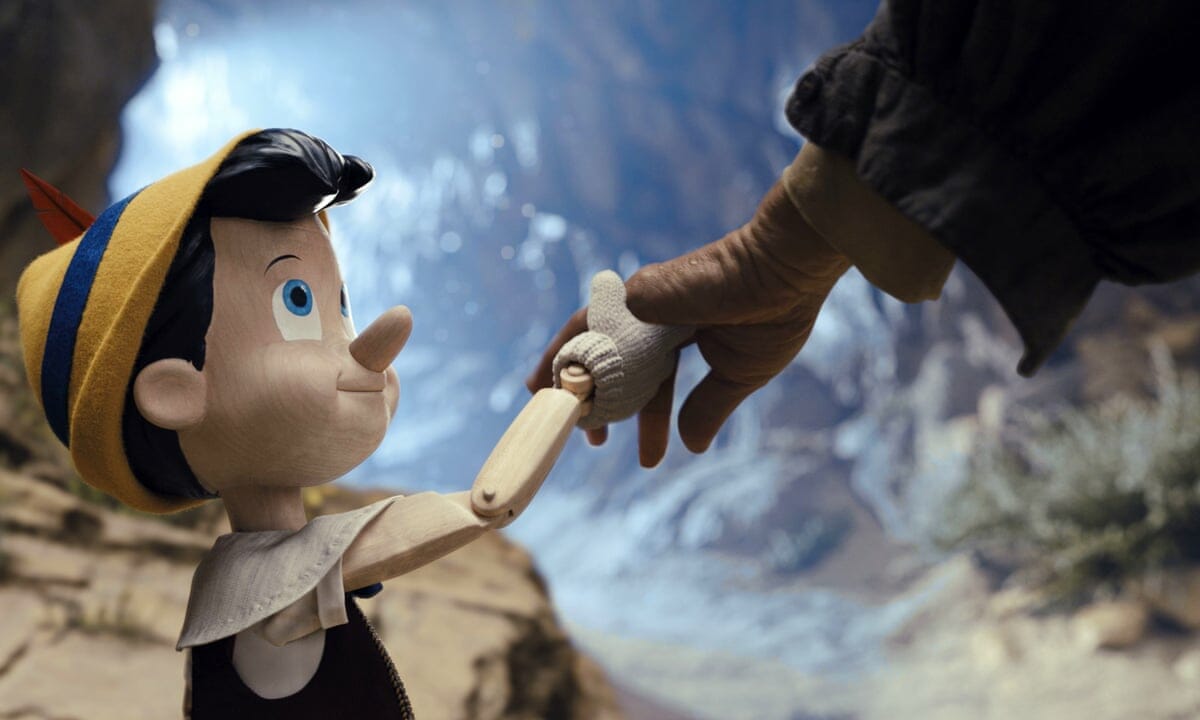Over the summer, a slew of visual effects artists came forward with claims that Disney and its subsidiaries have been abusing VFX teams for years. From overworking artists to the point of tears with ten-hour days and unstable deadlines to blacklisting teams that refuse their unreasonable demands—effectively halving the teams’ client bases, as Disney owns a precarious number of VFX-heavy properties—the house of mouse has been wrecking the homes of its visual foot soldiers. And after all the exploitation and crunch, they don’t even give artists a movie they can be proud of at the end of the day; instead, they give them Pinocchio.
The latest in a series of less and less justified live-action remakes, Pinocchio is, like many of its ilk, only barely live-action. It’s a few actors gallivanting around a CGI world, doing their darndest to pretend they’re interacting with characters who will hopefully be finished in time. Tom Hanks, fresh off the more acting-intensive Elvis, fills that role here as Geppetto, the lonely woodcarver who has once again wished upon a star for his puppet to be a real boy. Hanks does a serviceable job emoting into the void—you’ll believe a man can talk to a puppet—but he can’t convincingly interact with a world that’s not around him. He “holds” his kitten Figaro like he’s nervous the rushed CGI will rub off on him.
READ ALSO: Read all of Ryan Bordow’s movie reviews here
The quality of the VFX isn’t the only problem; the whole thesis behind these remakes is flawed. The classic stories simply do not impress in pseudo-live action. This is painfully obvious during the musical scenes, most of which Pinocchio retains from the 1940 original. In hand-drawn animation, the colors and brush strokes sing and dance with the characters, blending sight and sound into a flavorful, fervorful tapestry. In nu-Pinocchio, the music peters out into settings that aim for realism and achieve drab, like a songbird trapped in a mundane plastic cage. Reminiscent of the human voices spilling from lifelike animals in Disney’s Lion King remake, the form and content of Pinocchio rarely gel.
It’s especially embarrassing in the shadow of Guillermo del Toro’s stop-motion Pinocchio due later this year. The trailer for del Toro’s film displays more artistry than Disney does in 105 minutes. Stop-motion is a perfect medium for the story—a wooden boy overcoming his stiffness to find fluid, messy humanity. The consonance of theme and vision that del Toro could achieve is exciting. But like an evil twin keeping balance in the world, Disney’s Pinocchio reminds us that some tales are just mashed together for cash. It’s honestly surprising that Disney didn’t go the labor-intensive stop-motion route as well—just think of the worker abuse potential!
Pinocchio’s flaws extend past its reason for existence. A startling number of scenes are too dark to see, especially after the contemporary pop culture references and shameless Disney cameos have rolled your eyes far from available light sources. The screenplay, which follows the structure of the original yet is somehow 15 minutes longer, trades real tension for false danger. Pleasure Island, once famously disturbing for children, is little more than family-family unpleasantry now, but the whale is bigger and has a longer chase scene. Easy moralizing cripples the darker stuff as well: Pinocchio declared in the original that “being bad’s a lot of fun”, giving him a place to learn and grow from; in the remake, Pinocchio is instantly put off by hedonism when he’s cognizant enough to recognize it, which clarifies that being bad is bad (thanks Disney!) but makes Pinocchio as static as the VFX. The whole affair reeks of negligence.
Thankfully, Pinocchio is premiering solely on Disney+, so theater screens won’t have to lower themselves to this shlock. The double edge to that sword is increased accessibility, however, and the less accessible this movie is, the better. Like young people blocking Fox News on their parents’ TVs, we can make the world a better place by unsubscribing adults from Disney+. Do it for the VFX artists.
★½ (1.5/5)




